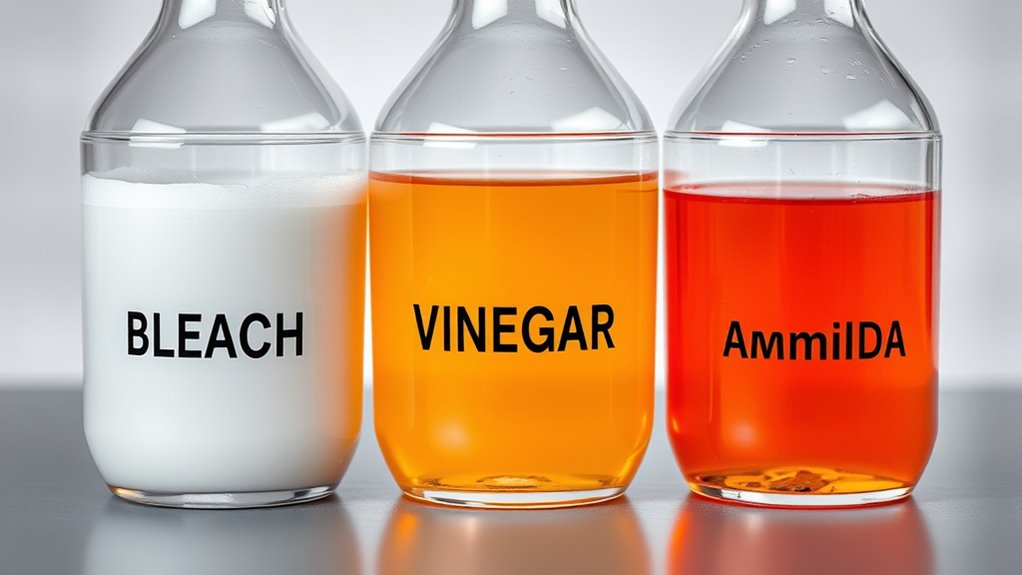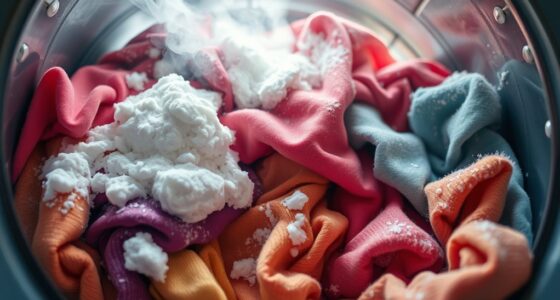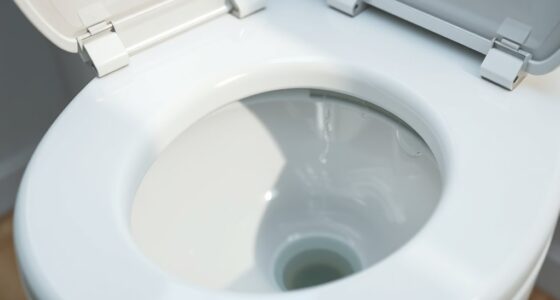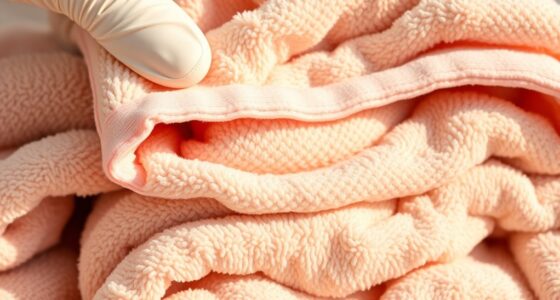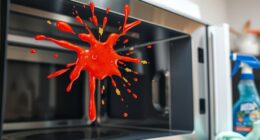Mixing bleach, vinegar, and ammonia is extremely dangerous because it releases toxic gases like chlorine, chloramine vapors, and hydrazine, which can cause severe respiratory, eye, and skin injuries. These reactions happen quickly, especially in confined spaces, creating unpredictable hazards. Long-term exposure can weaken your immune system and cause chronic health issues. To stay safe, it’s best to keep these chemicals separate and use safer alternatives—more important details await you if you continue exploring.
Key Takeaways
- Mixing bleach with vinegar releases toxic chlorine gas, which causes respiratory irritation and potential lung damage.
- Combining bleach and ammonia produces hazardous chloramine vapors and hydrazine, leading to severe respiratory and eye irritation.
- These chemical reactions are unpredictable, especially in confined spaces, and can cause long-term health issues like bronchitis.
- Always keep bleach, vinegar, and ammonia separate; never mix them to avoid dangerous gas formation.
- Use natural cleaning methods like baking soda and lemon to reduce chemical hazards and protect your health.
The Chemistry Behind Common Household Cleaners
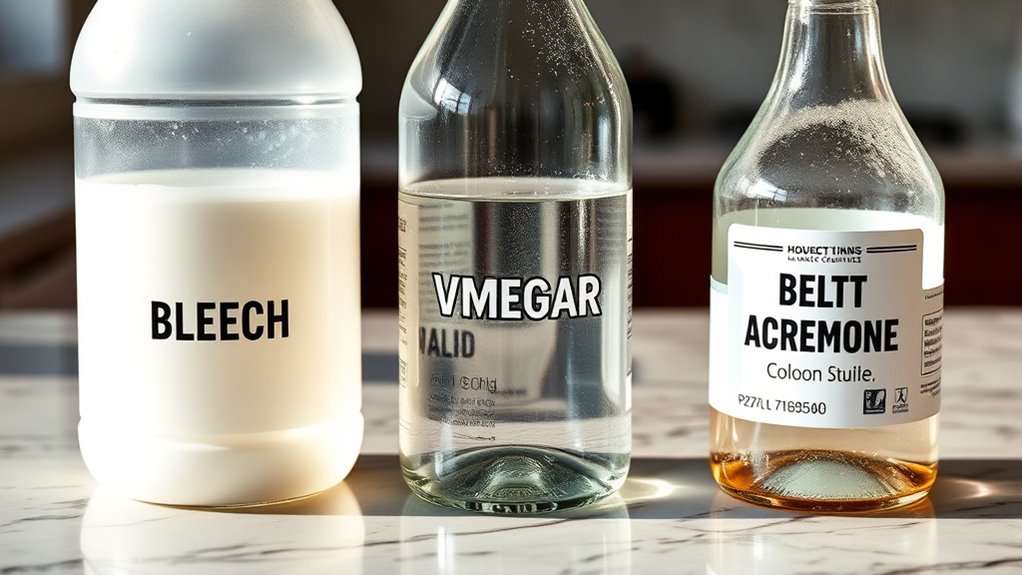
Understanding the chemistry behind household cleaners helps you use them safely and effectively. When you know how different substances interact, you can avoid dangerous reactions and maximize cleaning efficiency. Household chemistry involves common ingredients like acids, bases, and oxidizers, each designed to target specific messes. For example, acids such as vinegar break down mineral deposits, while bases like baking soda neutralize odors. Recognizing these chemical properties promotes cleaning safety, preventing accidental harmful reactions. Always read labels and understand what ingredients do—knowing how cleaners work helps you avoid mixing incompatible products. Being aware of cybersecurity vulnerabilities is also important when managing digital information related to household products. By understanding the chemistry behind your cleaning supplies, you become more confident in maintaining a safe, effective cleaning routine without risking dangerous chemical interactions.
What Happens When Bleach Meets Vinegar
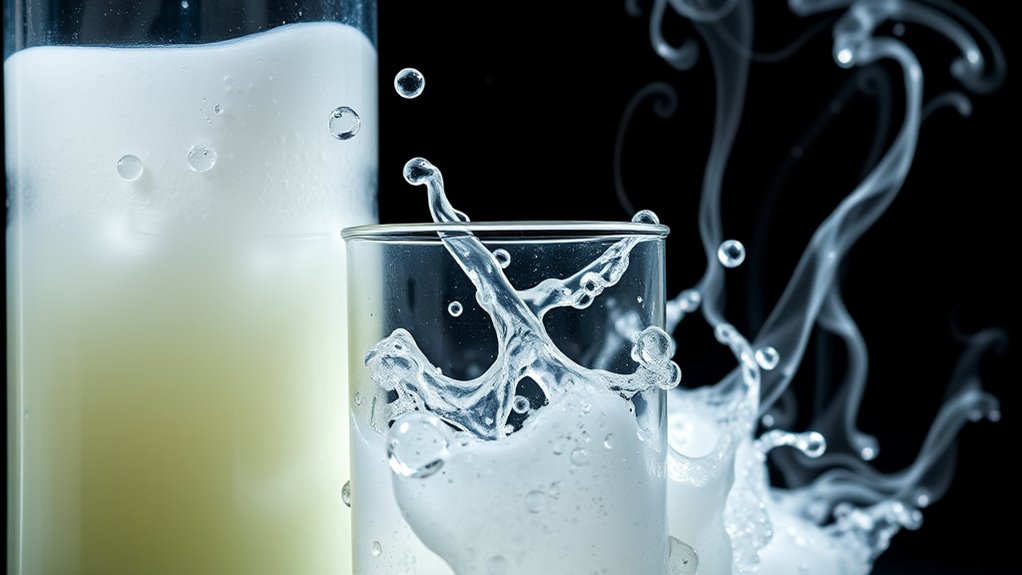
When you mix bleach and vinegar, a dangerous chemical reaction occurs, producing chlorine gas. This gas can irritate your respiratory system and even cause breathing problems. Understanding these risks helps you avoid potentially life-threatening situations in your home. High-risk chemical reactions can happen when combining household cleaners without proper knowledge.
Acidic Reaction Formation
Mixing bleach and vinegar can lead to a dangerous chemical reaction that releases toxic gases. When these substances combine, their pH imbalance causes a shift in chemical stability, resulting in the formation of chlorinated compounds. Vinegar is acidic, while bleach is a strong base, so their interaction creates an unstable environment. This acidity triggers a reaction where chlorine atoms from bleach combine with acids in vinegar, forming new compounds. These compounds can be highly reactive and release harmful gases. The reaction isn’t just dangerous—it also disrupts the chemical stability of the substances involved. Understanding artificial chemical reactions helps explain why these combinations are hazardous. Instead of creating a safe cleaning solution, you end up with unpredictable chemical reactions that pose serious health risks. Always avoid mixing bleach with vinegar to prevent these hazardous outcomes.
Toxic Chloramine Gas
If bleach and vinegar are combined, they can produce toxic chloramine gas, which poses serious health hazards. This hazardous reaction occurs because mixing acids with chlorine bleach releases chloramine vapors, damaging your respiratory system and eyes. To understand the process better, here’s a quick overview:
| Substance Involved | Resulting Gas |
|---|---|
| Bleach (sodium hypochlorite) | Chloramine gases (NH₂Cl) |
| Vinegar (acetic acid) | Facilitates chemical reaction |
These hazardous reactions highlight the importance of chemical safety. Always avoid combining bleach with acids like vinegar, as the resulting chloramine gas can cause respiratory issues, coughing, and eye irritation. Protect yourself by understanding the risks and never mixing these substances to ensure a safe environment. Proper celebrity lifestyle knowledge can help you stay cautious about chemical hazards at home.
Corrosive Material Risks
Vinegar and bleach should never come into contact because their chemical reaction can produce highly corrosive substances. When these two substances mix, the acid in vinegar reacts with the sodium hypochlorite in bleach, creating chlorine gas and other corrosive materials. Exposure to these corrosive material risks can cause severe damage to your respiratory system, skin, and eyes. The chemical reaction hazards escalate quickly, releasing toxic gases that can lead to respiratory distress or chemical burns. Even small amounts of the mixture pose serious dangers, so you must avoid combining bleach and vinegar under any circumstances. Understanding these risks helps you prevent dangerous chemical reactions and protect yourself from potentially life-threatening exposure to corrosive materials. Additionally, refrigerants used in heat pumps are carefully managed to prevent environmental harm, highlighting the importance of proper handling and safety precautions when dealing with chemical substances.
The Dangers of Combining Bleach and Ammonia
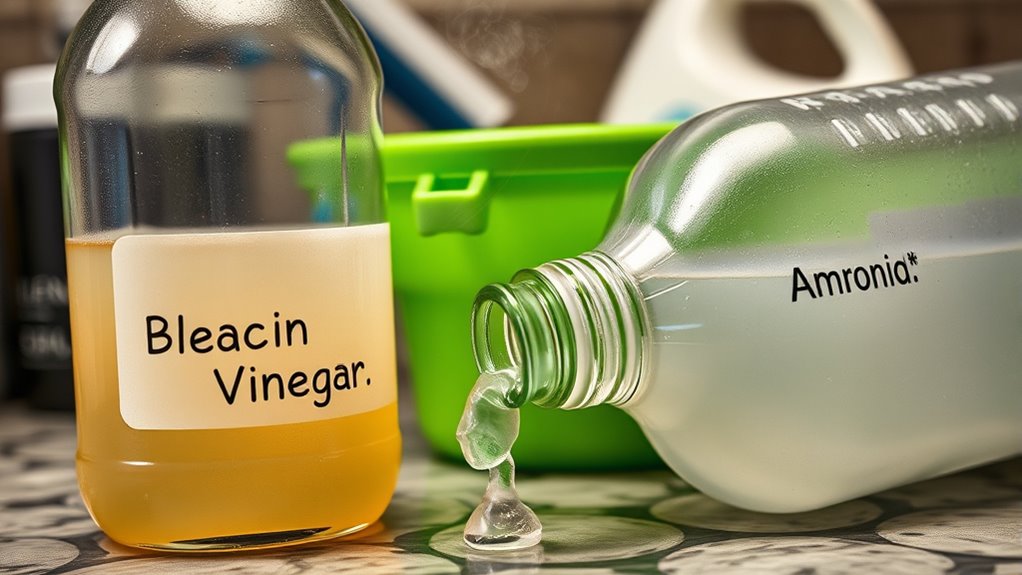
Combining bleach and ammonia is extremely dangerous because it produces toxic gases that can cause severe health problems. This household hazard results from a harmful chemical reaction that releases chloramine vapors and, in some cases, hydrazine. These gases are highly irritating to your eyes, lungs, and respiratory system, making breathing difficult and risking serious injury. Many people underestimate how quickly such reactions occur, especially in confined spaces. Mixing these substances creates a dangerous environment with unpredictable outcomes, and the resulting gases can linger long after cleaning. Always remember that household hazards like these aren’t worth the risk. Avoid combining bleach and ammonia under any circumstances, and keep these chemicals separate to protect yourself and others from dangerous chemical reactions. Proper chemical handling is essential for safety in any cleaning routine.
Toxic Gas Formation and Its Health Risks
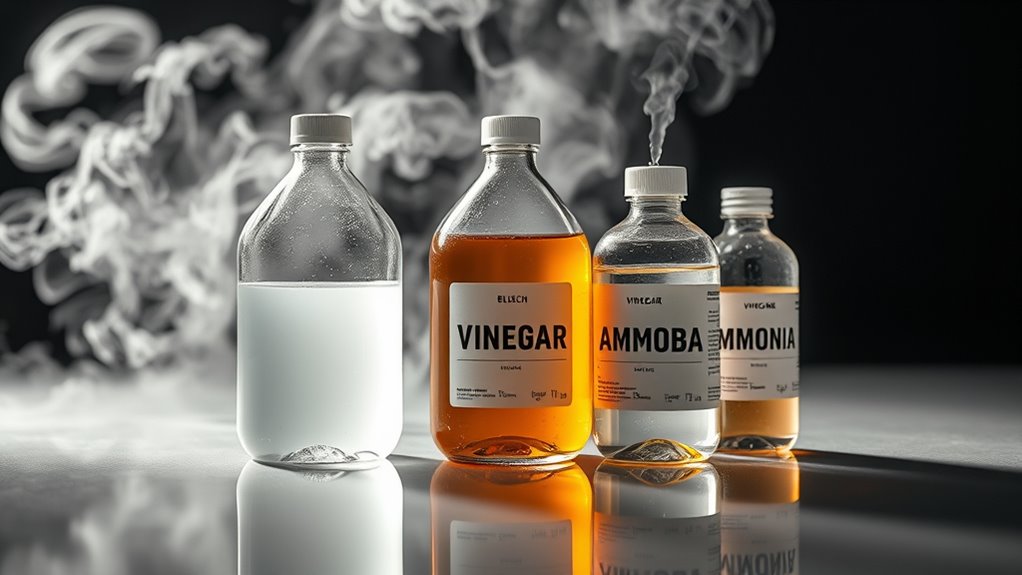
When you mix certain cleaning agents, toxic gases like chloramine can form and pose serious health risks. Inhaling these fumes can cause respiratory irritation, making it hard to breathe and irritating your eyes and throat. Prolonged exposure may lead to long-term health issues, so it’s essential to understand these dangers and avoid dangerous combinations.
Chloramine Gas Production
Although chloramine is often used as a disinfectant, mixing certain chemicals with it can produce toxic gases that pose serious health risks. When household safety isn’t maintained, unintended chemical reactions can release chloramine gas, which is highly dangerous. Combining bleach or ammonia with chloramine triggers the formation of chloramine vapors, which are toxic and can cause respiratory issues. These gases are produced rapidly during improper mixing, making it crucial to avoid combining cleaning agents unless you’re certain of their chemical compatibility. Exposure to chloramine gas can lead to coughing, shortness of breath, and eye irritation. Understanding chemical reactions is essential to prevent these hazards. To prevent these risks, always follow label instructions and never mix household cleaning products that contain these substances. Proper knowledge of chemical reactions is essential to ensure your safety during cleaning.
Respiratory Irritation Risks
Exposure to toxic gases produced during improper chemical mixing can cause immediate respiratory irritation, posing serious health risks. When these gases are inhaled, they can trigger airway inflammation and worsen respiratory symptoms like coughing, wheezing, and shortness of breath. Visualize the effects with this table:
| Gas Type | Respiratory Impact |
|---|---|
| Chloramine | Causes airway inflammation and cough |
| Chlorine Gas | Irritates lungs, triggers wheezing |
| Ammonia | Burns airways, causes breathing difficulty |
| Nitrogen Dioxide | Leads to coughing and chest tightness |
| Hydrogen Chloride | Causes severe respiratory discomfort |
Inhaling these gases can quickly impair your breathing, emphasizing why mixing chemicals is dangerous and should never be attempted. Proper understanding of grocery savings strategies can help you avoid unnecessary risks and expenses when shopping for household supplies.
Long-term Health Effects
Mixing chemicals improperly not only causes immediate respiratory irritation but also leads to the formation of toxic gases that can harm your health over time. Chronic exposure to these gases can weaken your immune system, making you more vulnerable to infections and illnesses. Long-term inhalation may cause persistent lung issues, such as reduced lung function or chronic bronchitis. The toxic compounds formed, like chloramines or nitrogen oxides, can accumulate in your body, gradually damaging essential organs. Even if you don’t notice symptoms right away, repeated exposure increases health risks. Protecting yourself means avoiding these dangerous chemical combinations. Proper ventilation and safe cleaning practices reduce the chance of long-term health effects, ensuring your immune system remains strong and your lungs stay healthy over time. Additionally, understanding the dangers of improper mixing is crucial in the context of Kia Tuning, where modifications involve various components that require careful handling to avoid hazards.
Recognizing Symptoms of Chemical Exposure

Recognizing the symptoms of chemical exposure is essential for prompt action and minimizing health risks. If you notice sudden irritation in your eyes, nose, or throat, it could be a sign of chemical sensitivity. Breathing difficulties, coughing, or wheezing may also indicate inhalation of harmful fumes. Skin irritation, redness, or burns suggest direct contact with strong chemicals. Headaches, dizziness, nausea, or fatigue can be signs of systemic toxicity. Being aware of symptom recognition helps you respond quickly—ventilate the area, remove yourself from the source, and seek medical help if symptoms worsen. Early detection of these signs can prevent more serious health problems. Trust your body’s signals and act immediately if you suspect chemical exposure. Recognizing early symptoms is vital to prevent long-term health issues.
Safe Cleaning Practices for Your Home
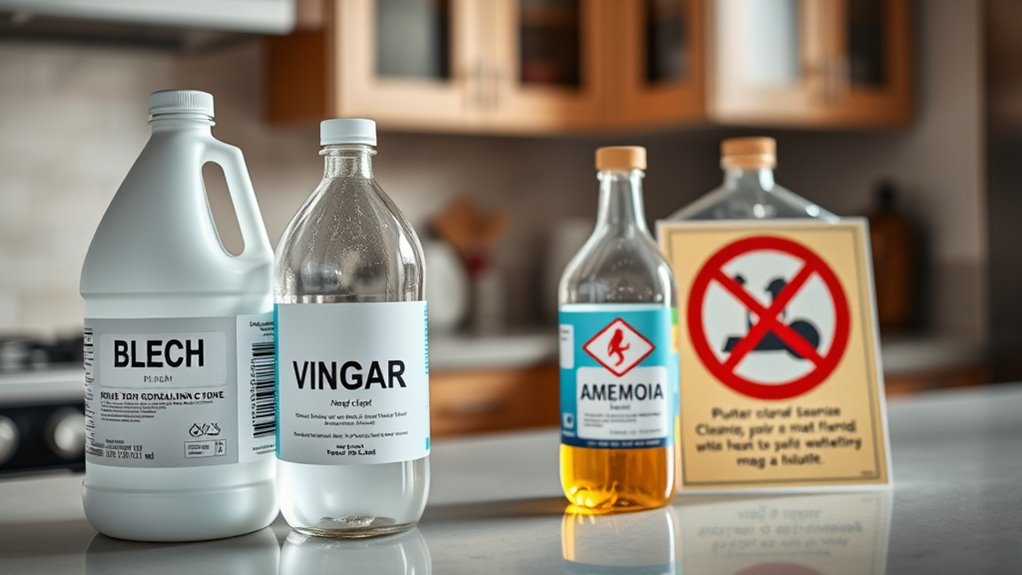
Keeping your home safe while cleaning starts with choosing the right products and using them properly. Many cleaning myths suggest mixing various chemicals to boost effectiveness, but this can be dangerous. Instead, focus on safe ingredient combinations, like using vinegar and baking soda separately for different tasks. Always read labels and follow instructions carefully. Ventilate rooms well while cleaning to avoid inhaling fumes. Avoid mixing bleach with ammonia or vinegar, as harmful gases can form. Store cleaning supplies out of children’s reach and never reuse containers meant for other purposes. Regularly clean high-touch surfaces with simple, proven solutions. Be aware that some cleaning agents, like aromatherapy oils, can cause adverse reactions if misused, especially around pets or children. By understanding safe cleaning practices, you reduce risks and protect your household. Remember, safe cleaning isn’t about shortcuts; it’s about making smart choices with the right ingredients.
Alternatives to Hazardous Mixtures
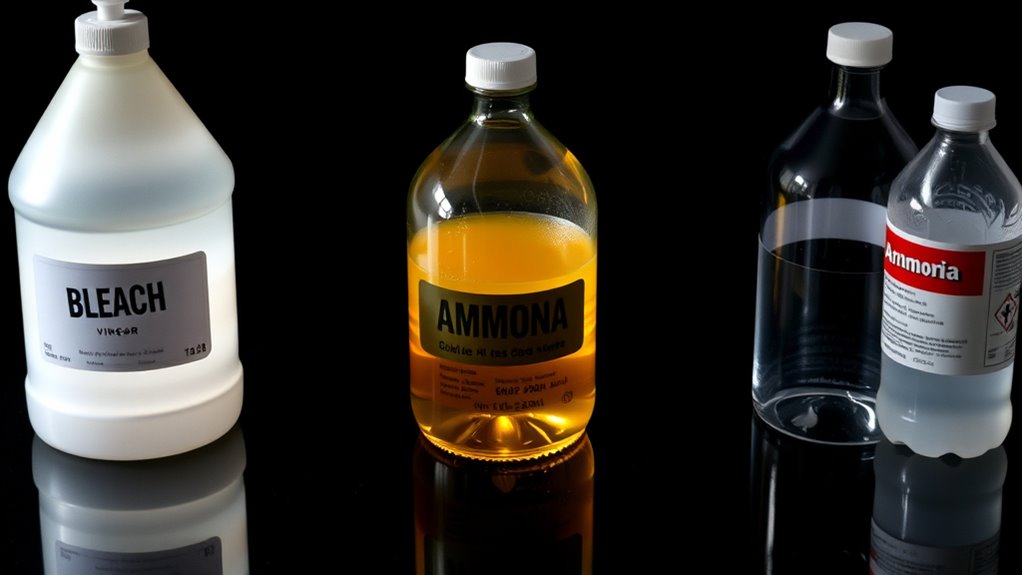
When cleaning, you don’t need to resort to hazardous mixtures to get effective results. Instead, try natural cleaning methods that are safe for your family and the environment. Vinegar, baking soda, and lemon are excellent eco-friendly alternatives that tackle dirt and stains without harmful chemicals. For example, vinegar can disinfect surfaces, while baking soda deodorizes and scrubs. Lemon adds a fresh scent and boosts cleaning power. These natural cleaning options are affordable, readily available, and non-toxic, making them ideal for everyday use. By choosing eco-friendly alternatives, you reduce the risk of dangerous reactions and lessen your carbon footprint. Additionally, understanding cookie management can help ensure your online privacy while researching eco-friendly products. Embracing natural cleaning not only keeps your home safe but also supports a healthier planet.
Frequently Asked Questions
Can Mixing Bleach With Vinegar or Ammonia Ever Be Safe?
You should never mix bleach with vinegar or ammonia because it causes dangerous chemical reactions. These reactions can release toxic gases that pose serious health risks, including respiratory problems or poisoning. Always follow safety precautions by keeping these substances separate and using them in well-ventilated areas. If you need to combine cleaning agents, consult the product labels or a professional to guarantee safe usage. Never compromise safety for cleaning convenience.
What Should I Do if I Accidentally Mix These Chemicals?
If you accidentally mix bleach with vinegar or ammonia, act quickly. First, evacuate the area to avoid inhaling toxic fumes. Call emergency services for proper chemical cleanup and guidance. Ventilate the space by opening windows and doors. Do not attempt to neutralize the chemicals yourself, as it can be dangerous. Prioritize safety and seek professional help immediately to guarantee a safe emergency response.
Are There Any Household Cleaning Mixtures That Are Safe to Combine?
You should prioritize household safety by avoiding mixing most household cleaning products unless the labels clearly specify they’re safe to combine. Many common mixtures can cause dangerous chemical reactions, releasing toxic gases or causing fires. Instead, use each product separately and rinse well between applications. Always read labels carefully, follow instructions, and keep cleaning supplies stored safely out of children’s reach to prevent accidental chemical reactions.
How Long Do Toxic Gases From These Reactions Linger in the Air?
The toxic gases from these reactions can linger in the air for several hours, depending on ventilation. To guarantee air safety, open windows and use fans to disperse the fumes quickly. Avoid re-entering the space until you’re confident the gas lingering has dissipated. Proper ventilation is key to clearing out harmful gases and maintaining a safe environment after mixing or cleaning with these substances.
What Are the Long-Term Health Effects of Chemical Inhalation Exposure?
Your health risks from chemical inhalation can be severe, like a silent predator stalking you over time. Long-term exposure may cause chronic respiratory issues, making every breath a challenge, and neurological impacts that could impair your memory and focus. Even brief inhalation of toxic gases might leave lasting effects, so it’s crucial to avoid mixing chemicals and guarantee proper ventilation to protect your well-being from these invisible dangers.
Conclusion
So, next time you’re tempted to mix bleach, vinegar, and ammonia, remember this: your home’s safety isn’t worth the science experiment. Ironically, what’s meant to clean can turn into something dangerous in seconds. Stick to proven safe methods instead of risking your health for a quick fix. After all, a clean home shouldn’t come at the cost of your well-being—sometimes, the safest choice is simply to keep these chemicals apart.
